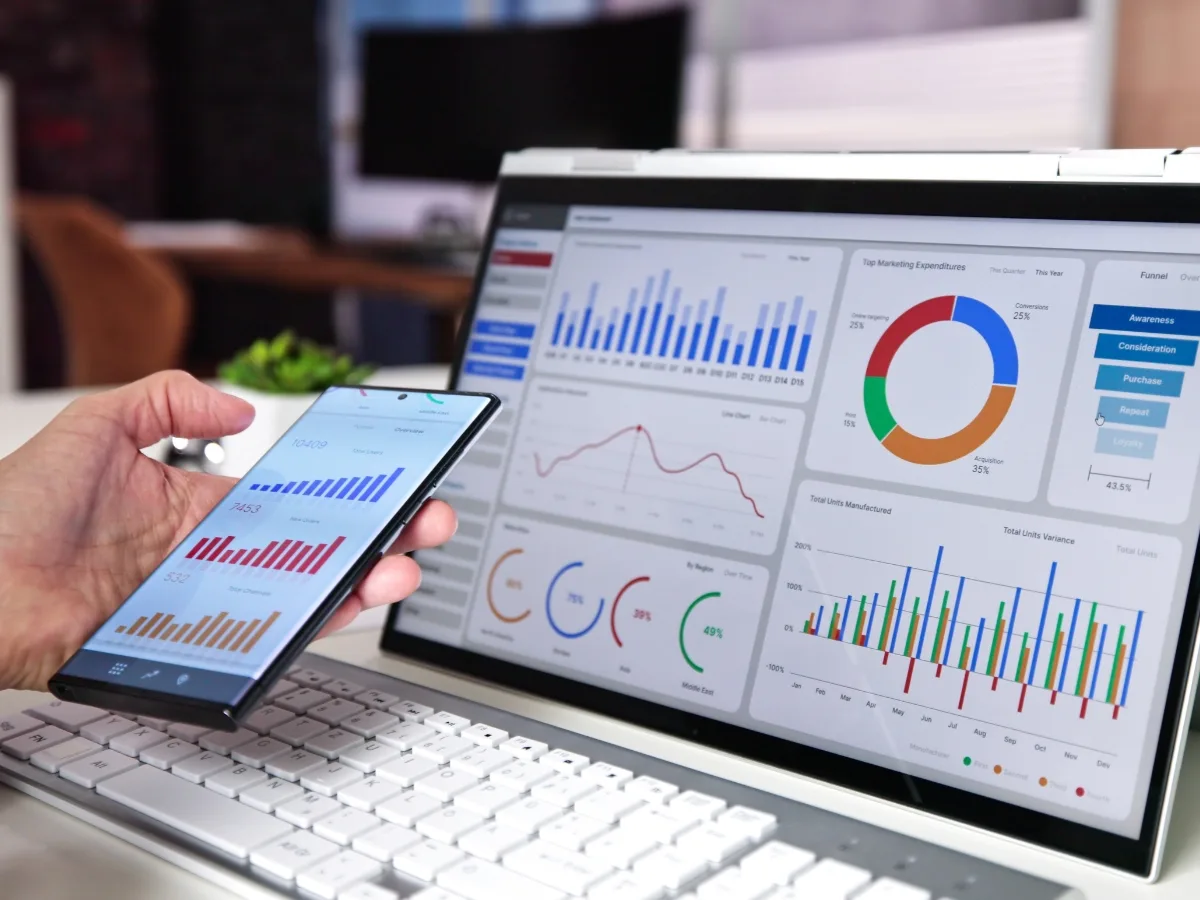Predictive analytics transforms historical customer data into reliable marketing forecasts, enabling small businesses to anticipate demand, personalize outreach, and maximize return on every dollar spent. In today’s fast-paced digital landscape, businesses that anticipate customer needs and market shifts gain a powerful competitive edge—and predictive analytics makes that possible.
By leveraging data, AI, and statistical algorithms, marketers can forecast trends, personalize campaigns, and optimize strategies with unprecedented precision. From predicting customer behavior to identifying emerging opportunities, predictive analytics transforms raw data into actionable insights.
In this guide, we’ll explore how this cutting-edge approach is revolutionizing marketing, helping brands stay ahead in an ever-evolving marketplace.
Predictive Analytics in Marketing: The Future Is Now
Optimizing Small Business Marketing with Predictive Analytics

Predictive analytics uses statistical algorithms and machine learning to identify patterns in past data, enabling forecasts that guide marketing decisions and boost campaign effectiveness. By processing transaction histories, website behavior, and CRM records, predictive models can anticipate customer preferences—such as predicting which prospects are most likely to convert. For example, a local café might analyze loyalty-card data to forecast weekend foot traffic and tailor promotions accordingly. Understanding predictive analytics equips small businesses to shift from reactive to proactive strategies, reducing waste and increasing revenue.
How Does Predictive Analytics Differ from Traditional Marketing Analytics?
Traditional marketing analytics focuses on reporting what happened—click-through rates, past sales, or campaign ROI—while predictive analytics looks ahead, estimating future outcomes based on historical trends. Reporting tools summarize performance metrics, but predictive models apply machine learning to historical datasets, uncovering hidden patterns such as seasonal purchase cycles or customer churn signals. This forward-looking capability empowers SMBs to allocate budgets proactively and engage customers before they defect, rather than simply measuring past performance.
Core Components of a Predictive Analytics Workflow
First, data collection brings together information from point-of-sale systems, website logs, social media, and customer profiles. Cleaning and unifying that data ensures accuracy.
Next, algorithms—ranging from regression models to classification trees and clustering methods—analyze inputs to identify key drivers of customer actions.
Finally, validation requires testing model predictions against a reserved subset of data, refining parameters until accuracy meets business needs. Once validated, models integrate with marketing platforms to trigger personalized offers, adjust bid strategies in real time, or alert sales teams to at-risk accounts.
How Does Predictive Analytics Forecast Future Marketing Trends?
At its core, forecasting uses time-series analysis and pattern recognition to extrapolate future behavior from historical data points. Models track variables like seasonality, promotional responses, and website engagement to predict metrics such as sales volume, customer lifetime value, or churn probability.
For example, a boutique shop might forecast quarterly revenue by analyzing three years of holiday-season purchases, enabling better inventory planning and targeted email campaigns. This process ensures small businesses can plan campaigns around expected demand rather than reacting to unplanned surges or slowdowns.
Measuring Impact and Refining Models
Success depends on measuring predictions against actual outcomes. Key performance indicators—such as lift in conversion rates, reduction in customer acquisition cost, or increased lifetime value—demonstrate the value of predictive campaigns. Regularly reviewing model performance ensures that unexpected market shifts or data changes don’t erode accuracy. Over time, refining algorithms and incorporating new data sources—like mobile app behavior or geolocation signals—enhances precision, making forecasts ever more reliable.
What Are the Top Benefits of Predictive Analytics for Small Business Marketing?

Predictive analytics gives small businesses a clear view of what’s likely to happen next, turning marketing spend into measurable outcomes rather than educated guesses. By analyzing past transactions, website behavior, and customer profiles, these tools forecast which campaigns will deliver the best returns, which audiences are most likely to buy, and which customers might drift away. This data-driven approach helps allocate budgets more efficiently, sharpen customer targeting, and reduce waste—ultimately boosting overall marketing return on investment.
Sharper Customer Targeting and Segmentation
Traditional audience segmentation often relies on broad categories like age or location. Predictive analytics, however, uncovers the specific behaviors and attributes that drive purchases. Models can spot “weekend high spenders” who respond best to timed offers or identify visitors who habitually wait for discounts before buying.
As each customer interacts with your site, their segment scores update in real time, ensuring that email messages, social ads, and on-site promotions stay highly relevant. By concentrating efforts on prospects with the greatest predicted value, businesses see higher conversion rates and lower customer acquisition costs.
Proactive Retention and Churn Prevention
Keeping a customer is far more cost-effective than finding a new one. Predictive techniques analyze metrics such as purchase frequency, average order value, and site engagement to flag customers at risk of churning. When a shopper’s activity dips below their normal pattern, the system triggers tailored re-engagement campaigns—perhaps a limited-time discount or an exclusive preview of new products.
Companies that adopt churn-prediction models typically reduce attrition by up to 20 percent. By addressing potential issues before customers leave, businesses maintain steadier recurring revenue and strengthen long-term loyalty.
Optimized Marketing Spend and ROI
Rather than dividing ad budgets equally or relying on gut instinct, predictive analytics allocates resources to the channels and messages most likely to succeed. Historical performance data combined with forward-looking models suggest how much to invest in search, social, display, or retargeting efforts. Automated bid-management tools adjust in real time, focusing on high-value keywords and audience segments that deliver the greatest return.
Businesses putting dollars behind predictive forecasts consistently see 10 to 25 percent higher ROI compared to manual budgeting, making every marketing dollar stretch further.
Data-Driven Decision Making Across the Board
Moving from intuition-based choices to evidence-based strategies transforms how small businesses plan and react. Predictive dashboards distill complex forecasts into clear visualizations of expected sales trends, customer segment growth, and campaign outcomes. Owners can test “what if” scenarios—such as adding a holiday promotion or launching a new product—and see projected impacts before committing budgets. This agility lets SMBs adjust tactics on the fly, capitalize on emerging opportunities, and address underperforming campaigns before they drain resources. In a competitive landscape, turning raw data into actionable insights levels the playing field with larger enterprises that have more extensive marketing teams.
How Is Predictive Analytics Applied in Digital Marketing for Small Businesses?

Predictive analytics turns raw data into a roadmap for your small business’s marketing efforts. By examining customer behavior, transaction histories, and engagement patterns, it forecasts future trends—identifying which prospects are most likely to buy, which channels will deliver the best return, and which clients risk drifting away.
This proactive insight replaces guesswork with precision, allowing you to tailor messages, allocate budgets, and schedule campaigns based on evidence rather than intuition, in an environment where every marketing dollar counts. Predicting customer needs and market shifts gives small businesses a crucial edge.
Enhancing Local SEO with Forecasted Search Behavior
Small businesses can stay ahead in local search by using predictive analytics to spot rising keywords and seasonal patterns for local SEO. By examining past query volumes, models forecast spikes in phrases like “laptop repair near me” or “best vegan bakery.” Anticipating these trends lets you optimize Google Business Profiles, update location pages, and request reviews before demand peaks. Geo-targeted forecasts also reveal which ZIP codes will drive the most traffic, so you can tailor promotions and ad spend to neighborhoods where conversion rates are projected to be highest.
Delivering Personalized Customer Journeys
Predictive analytics transforms generic marketing into individualized experiences. By analyzing clickstreams, purchase histories, and engagement metrics, you can recommend the right products, content, and offers to each visitor. Email campaigns may automatically send refill reminders when a customer’s next-purchase date approaches.
On your website, dynamic content blocks adapt headlines and visuals based on intent scores—so a shopper showing interest in winter gear sees seasonal promotions front and center. Even ad creative can be selected automatically: banners and copy variants predicted to resonate with a given audience boost click-through rates and encourage repeat visits, increasing overall engagement by up to 30 percent.
Optimizing Channel Mix and Campaign Timing
Not all marketing channels deliver equal returns. Predictive attribution models estimate which touchpoints—search, social, email, display—are most likely to influence conversions. Armed with these insights, you can shift budgets toward under-utilized channels with the highest predicted impact.
Forecasts also pinpoint the best windows to launch promotions: by correlating historical engagement spikes with external factors like holidays or local events, campaigns go live precisely when customer interest is highest. Creative elements can be tested ahead of time—models predict which ad variations will outperform, enabling A/B testing that maximizes ROI and minimizes wasteful ad spend.
Prioritizing Leads with Predictive Scoring
For small sales teams, time is precious. Predictive lead scoring ranks prospects by their likelihood to convert, using attributes such as firmographics, website behavior, and past campaign interactions. Leads with top scores receive immediate outreach, while lower-priority contacts enter a nurturing sequence until their score improves.
Companies that adopt predictive scoring often see a 50 percent increase in sales efficiency, as reps focus on high-value opportunities rather than chasing unqualified prospects. Seamless integration between your CRM and marketing automation ensures that these scores trigger the right actions at the right time.
Data-Driven Content Planning
Creating content that resonates starts with knowing what your audience wants next. Predictive models analyze past performance—page views, social engagement, and conversion rates—to recommend topics and formats before they become mainstream.
If data shows rising demand for “sustainable home decor,” you can line up blog posts, videos, and social posts on that theme weeks in advance. Models also suggest optimal publishing times based on when your audience is most active online. Content gap detection highlights underserved local search terms, guiding article ideas that capture untapped traffic. The result is a content calendar that aligns every piece of collateral with projected audience interest, maximizing organic reach and customer engagement.
How Can Small Businesses Implement Predictive Analytics Successfully?

Predictive analytics can transform a small business’s marketing from reactive to proactive by turning existing data into clear forecasts. Instead of guessing which campaigns will work, you use patterns in customer behavior to anticipate needs, optimize budgets, and boost ROI. Implementing this approach successfully means choosing the right tools, building a clean data foundation, acknowledging common hurdles, and learning from real-world success stories.
Choosing the Right Predictive Analytics Tools
Small businesses should look for platforms that balance power with ease of use and integrate smoothly into existing workflows. Google Analytics now offers predictive metrics—such as churn probability and revenue forecasts—directly alongside your website data. HubSpot’s built-in predictive lead scoring ranks prospects by conversion likelihood without custom coding. Microsoft Power BI provides drag-and-drop dashboards and forecasting functions for those comfortable with visual analytics.
For teams ready to explore automated machine learning, DataRobot can build and deploy models with minimal technical setup. Selecting a tool that connects to your CRM, CMS, and ad platforms accelerates insights and reduces manual effort.
Building a Unified, High-Quality Data Foundation
Accurate forecasts depend on clean, consistent data. Start by centralizing customer information—CRM contacts, point-of-sale transactions, email engagement, and website behavior—into a single data warehouse or integration hub. Deduplicate records, standardize fields (for example, ensure all dates follow the same format), and enrich profiles with demographic or firmographic details from third-party sources.
Use APIs and pre-built connectors to automate real-time data flows from Google Analytics, your email service provider, and ad networks into your predictive platform. A solid integration pipeline ensures models run on the most up-to-date, complete data possible.
Overcoming Common Implementation Challenges
Small teams often face resource constraints, data-quality issues, and technical hurdles. Incomplete or erroneous customer records will lead to inaccurate predictions, so invest time early in data cleansing. If you lack in-house analytics expertise, consider partnering with a provider that offers guided setup and training—this speeds adoption and builds internal capabilities.
When integrating disparate systems, start with one or two key data sources before scaling up. Clear documentation of data mappings and transformation rules helps prevent confusion and ensures that everyone understands how inputs feed forecasting models.
What Are the Emerging Trends and Future Outlook for Predictive Analytics in Small Business Marketing?

Predictive analytics is no longer a luxury—it’s becoming essential for small businesses seeking to compete with larger players. As data volumes grow and AI algorithms improve, these tools will move beyond simple sales forecasts into real-time decision engines that shape customer experiences, automate marketing workflows, and reveal new revenue streams.
AI’s Expanding Role in Predictive Marketing
Artificial intelligence is driving significant improvements in model accuracy and scope. Deep learning techniques uncover complex patterns in customer interactions, while natural language processing allows systems to interpret sentiment and intent from unstructured text. Chatbots powered by these advances can predict what a visitor wants before they even type a question, triggering personalized promotions in real time.
Voice-search analytics will refine local SEO by anticipating natural-language queries, ensuring businesses rank for the phrases customers actually speak. Generative AI will automate content creation, drafting blog posts or social updates based on predicted topic relevance and seasonal trends, freeing small teams to focus on strategy rather than first drafts.
Automating the Customer Lifecycle
Tomorrow’s predictive models won’t just inform your next campaign—they’ll orchestrate your entire marketing funnel. Imagine a sequence that triggers email reminders when a subscription is likely to lapse, adjusts ad bids the moment a prospect’s engagement score jumps, or serves pop-up offers exactly when a visitor looks ready to abandon their cart.
Dynamic pricing engines will tweak product rates in real time based on demand forecasts, helping maximize margins during busy seasons and clear inventory during slow periods. Cross-sell and upsell suggestions will move from static “customers also bought” lists to hyper-targeted recommendations driven by each user’s unique behavior profile.
Emerging Digital Marketing Applications
Predictive analytics is spawning entirely new tactics for small businesses. Augmented reality ads can surface interactive product demos only for the demographics most likely to engage, increasing both novelty and conversion rates. Influencer partnerships will be chosen based on forecasted audience overlap rather than follower counts alone, driving more authentic endorsements. Blockchain-enabled data sharing offers a future where small enterprises can pool anonymized customer insights across a network, improving forecast quality without sacrificing privacy.
Frequently Asked Questions
What types of data are most useful for predictive analytics in small businesses?
For small businesses, the most useful data types for predictive analytics include customer transaction histories, website behavior, social media interactions, and CRM records. This data can be structured, such as sales figures, or unstructured, like customer reviews. By analyzing these diverse data sources, businesses can identify patterns and trends that inform marketing strategies, enhance customer targeting, and improve overall decision-making. The more comprehensive and clean the data, the more accurate the predictive models will be.
How can small businesses ensure data quality for predictive analytics?
Ensuring data quality for predictive analytics involves several key practices. First, businesses should regularly cleanse their data to remove duplicates and correct inaccuracies. Standardizing data formats across different sources is also crucial. Additionally, enriching datasets with third-party demographic information can enhance insights. Implementing a unified data warehouse can help centralize and streamline data collection, making it easier to maintain high-quality data for analysis. Regular audits and updates to data management processes are essential for ongoing accuracy.
What role does machine learning play in predictive analytics for small businesses?
Machine learning plays a pivotal role in predictive analytics by enabling models to learn from historical data and improve their accuracy over time. It allows small businesses to identify complex patterns and relationships within their data that traditional statistical methods might miss. By employing algorithms such as regression, classification, and clustering, businesses can make more informed predictions about customer behavior, sales trends, and marketing effectiveness. This capability helps small businesses optimize their strategies and allocate resources more efficiently.
How can small businesses measure the success of their predictive analytics efforts?
Measuring the success of predictive analytics efforts can be done through various key performance indicators (KPIs). Businesses should track metrics such as return on investment (ROI), customer acquisition costs, conversion rates, and customer retention rates. Additionally, comparing predicted outcomes with actual results can provide insights into model accuracy. Regularly reviewing these metrics allows businesses to refine their predictive models and strategies, ensuring continuous improvement and alignment with business goals.
What are some common pitfalls small businesses should avoid when implementing predictive analytics?
Common pitfalls include neglecting data quality, underestimating the importance of data integration, and failing to involve key stakeholders in the process. Small businesses may also struggle with overcomplicating their models, leading to confusion and misinterpretation of results. Additionally, not setting clear objectives for predictive analytics can result in wasted resources. To avoid these issues, businesses should focus on a clear strategy, prioritize data quality, and ensure that their team is trained to interpret and act on the insights generated.
How can small businesses stay updated on the latest trends in predictive analytics?
Staying updated on the latest trends in predictive analytics can be achieved through various methods. Subscribing to industry newsletters, attending webinars, and participating in relevant conferences can provide valuable insights. Engaging with online communities and forums focused on data analytics can also facilitate knowledge sharing. Additionally, following thought leaders and organizations in the field on social media platforms can help businesses stay informed about emerging technologies and best practices in predictive analytics.
Conclusion
Predictive analytics is revolutionizing marketing by turning data into actionable insights—helping businesses anticipate trends, optimize campaigns, and stay ahead of the competition. At Newman Web Solutions, we specialize in leveraging these powerful tools to craft data-driven digital marketing strategies that deliver measurable results.
Ready to future-proof your marketing? Call us today at (404) 301-9189 or schedule your free 30-minute strategy session to discover how predictive analytics can transform your business growth. With Newman Web Solutions, you’re not just keeping up with trends—you’re forecasting them.





